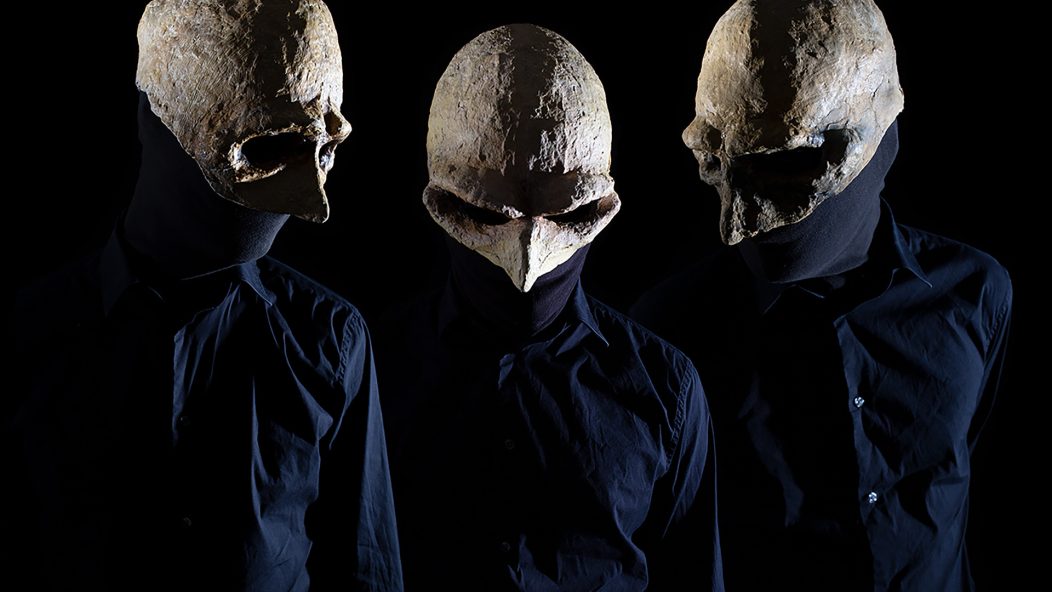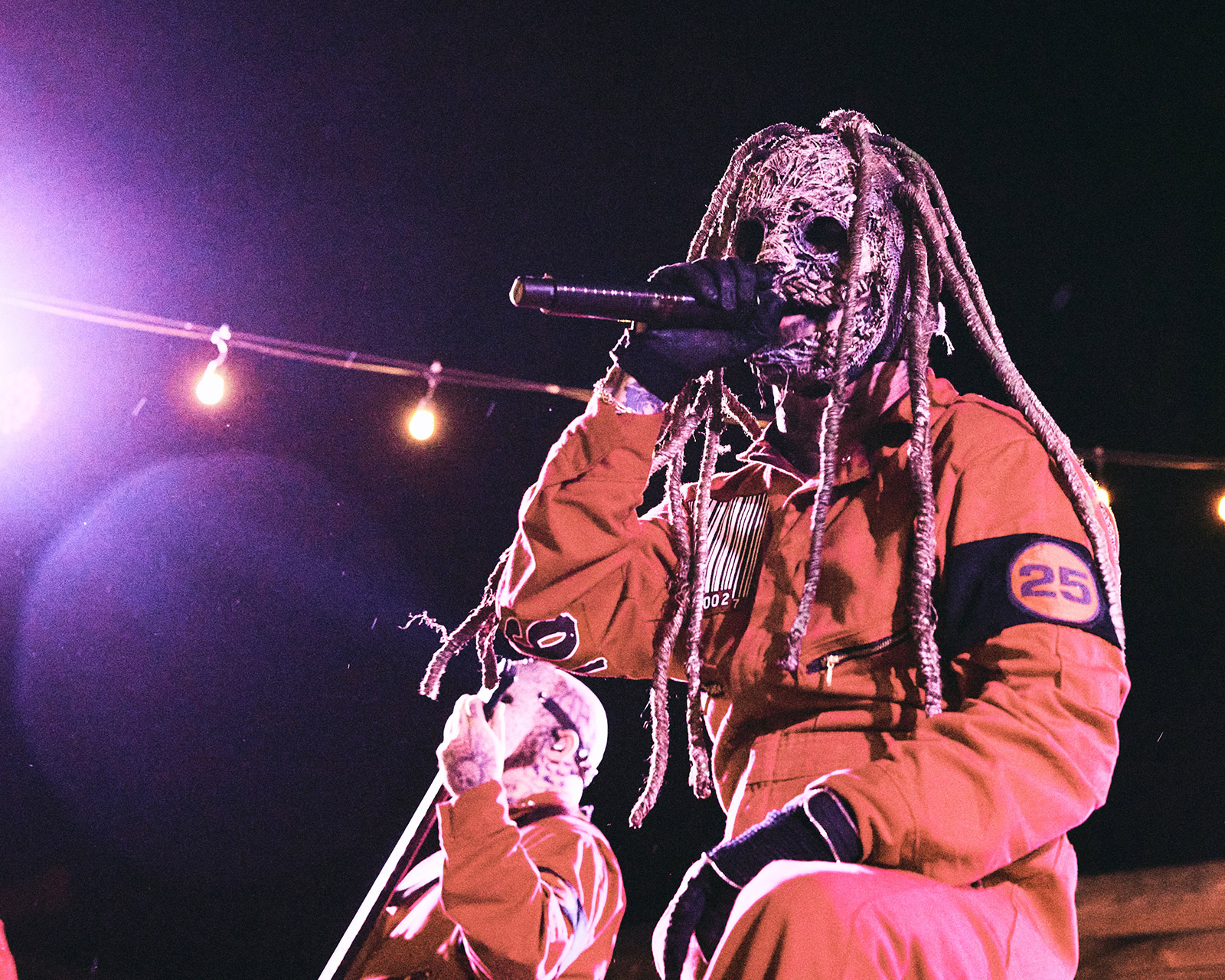
Laster on Inscrutable Black Metal (Interview)
The masked Dutch trio Laster’s evolution from inscrutable black metal to what they describe as “obscure dance music” has been one of the year’s best surprises. It certainly wasn’t foretold on their dense 2014 album De verste verte is hier, which sounds like an entirely different band compared to the Laster that recorded the recently-released Andermans Mijne, despite the fact they were made by the same members. What’s also surprising is how much they’ve appeared on Invisible Oranges in 2023.
Earlier this year, guitarist and vocalist Nicky H. interviewed Archspire’s Dean Lamb with the enthusiasm of a child getting their band memorabilia officially autographed. Nicky also contributed to Colin Williams’ inspection of the Utrecht black metal scene, which claims some of the most forward-thinking bands in the genre. The city’s philosophy is that black metal is a foundation rather than a rulebook, and Laster reflect that mentality on Andermans Mijne. They pay homage to black metal but are ultimately more interested in combining its elements with post-punk and dance music tenets. As Richard Currie said in his review, “You’re not required to undergo a demonic ritual under a funeral moon to get jiggy with what the band yearns to do.”
Thus, obscure dance music ceases to be a prescriptive term but a deductive conclusion. Andermans Mijne is far away from the negative existentialism black metal grapples with so well. Laster would rather engage with immediate subjects, like modernity’s humdrum gray palette and how it affects the individual, even though it’s cloaked by jaunty rhythms and gothic flirtations. Without being overly saccharine, Laster espouse a modest optimism that’s absent from black metal, both on an auditory and a conceptual level. Group members Nicky, Sylwin, and Wessel were kind enough to explain their reasons for expanding their musical palette, the origins of their obscure dance music title, and showcase their stellar sense of humor.
…
…
You have a great sense of humor, evidenced by your answer that “blast beats make music coherent” here and your long list of influences here—How does your humor interact with your music?
Nicky: Occasionally, little jokes sneak into the music. Sometimes as a quick moment, other times as a fully-fledged segment. More importantly, though, humor keeps us somewhat grounded amidst the heavier themes we approach and explore.
In several interviews, you’ve mentioned your music is about the mundane aspects of your lives. How do you think your music and art act as a way for you to better appreciate and reflect on life’s mundanity?
Sylwin: Music and art in general provide loose though fundamental frameworks for reflections and acts. They motivate and provide purpose. They generate bliss when you get to (finally) dance.
Wessel: As we are human creatures, we naturally seek to connect. Even though we initially became friends because we started to write music together, the friendship itself has grown deeply and allowed me as a person to grow. I cannot say enough how grateful I am for this. Our daily lives have become intertwined with each other as well. We eat at each other's homes weekly; we laugh and cry together, see relations come and go, all of it. To NOT talk about these very essential things in our art would feel dissociated and fake to me. It’s a necessity.
Your music has shifted away from overt black metal and towards art rock. How has your perception and relationship with black metal changed over the years with Laster?
Nicky: I no longer actively search for it. Collectively grinding through the depths of SoulSeek and Blogspot as teens and adolescents gave a rich understanding of the genre’s beginnings and developments up until the 2010s. After that, I lost sight of things. I still occasionally check in to get a grasp of current developments—but the genre has surely shifted from being a strong part of my identity to an appreciated toolset.
Sylwin: I have never been an overt black metal fan, but the approach of primitive blast beats and punk-ish styles of percussion in accordance with atmosphere is still part of what I crave in music—sometimes when I write music on my own, for example. Though not with Laster, because our band carries other potentials artistically and often does not fit with black metal elements. We just want to travel a lot.
Wessel: Some black metal bands have shown me all kinds of possibilities within the genre. Maybe (black metal is) one of the fewer metal styles that is a bit ambiguous within itself. What black metal should be has never interested me. Some elements get me more excited, some less. I’m both a big fan of steady, catchy rock beats as well as full-on blasting. Over the past few years, I’ve been playing all of ‘em and with a lot of joy. As far as shifting away from one style to another, did we really? All elements have been there, and probably always will be. Maybe more immersive.
Andermans Mijne, out of all your albums, best fits your self-identified “obscure dance music” label. What made you three identify with that idea?
Wessel: Thank you for this comment! I think we came up with this term when we were working on De verste verte is hier. We had written and recorded all four songs and noticed that the title song was diverting a lot from the other three songs in regards to style. To me, there wasn’t a single moment of hesitation about IF we would place this song on the record, but it did raise the question about WHAT we were trying to achieve stylistically.
The waviness and goth elements in this song felt very natural, and it was very fun to play, and I think I’ve never made such a poppy song before. It was new, fresh, and exciting. It made me so much more excited than the other songs on the record, actually, because it gave a glimpse of what we could be doing instead of just playing black metal music. It gave us the hope that our future music was going to be something different. So we decided to come up with our own interpretation of our style. If there’s anybody who should name this kind of music, it was going to be us. So we did. Surely, over the course of the past years, we kept reflecting on our self-fulfilling prophecy, and we think we actually made the music even more danceable, haha. So, glad that you agree.
On a similar note, what are the different lessons you learned from dance music that you didn’t learn from black metal, and vice versa?
Nicky: Groove teaches us to nurture the spiritual by including the physical.
Sylwin: The pink elephant called euphoric sensations.
Earlier this year, you spoke to our Colin Williams about Utrecht and DIY scenes in the city. How did the spirit of those scenes impact Laster’s ideology?
Sylwin: It did impact us for a while. Most importantly through how we came to work with other artists from other bands, formed new bands, played shows together, each other's attitudes, learned new stuff from all that. Frankly enough, Laster has developed into a very tight friendship built on shared values of musical creativity, openness, and aspiration. This I share most intensively with these two guys.
Similarly, you guys play it pretty loose with black metal. How do you think Utrecht black metal bands like Grey Aura and others affected your ambitions? Is it, as the saying goes, something in the water in Utrecht?
Nicky: Recent research reveals that the Netherlands boasts the highest levels of MDMA and THC-COOH in their sewage waters compared to other European nations.
Sylwin: Being a part of Grey Aura myself, I believe that in both bands, we like to be challenged to travel and go on an adventure not really knowing where to end up.
How do your masks play into your music and appearance? What do they provide to you as a musician that you couldn’t do without them?
Nicky: Sweat. Buckets, no, truckloads of sweat.
Sylwin: A visual linkage to the music through which the latter becomes more tangible.










